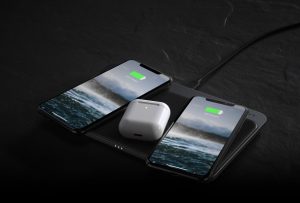“I was born in 2000, I have always lived my life with technology, there hasn’t been any moment without it.” So begins the story of Kai Landre, who recently traveled to the United States from Barcelona to explain his decision to become a cyborg.
Strictly speaking, a cyborg is any human being who incorporates—imports into one’s body—artificial devices or machines. And by that definition, even a person with a pacemaker would qualify. But Landre, a child of the new millennium, means something quite different. He has chosen to be permanently connected to a machine because, he says, it makes him feel more fully himself. He is aware that some may see this as a paradox.
“There are a lot of people who are afraid of stopping being human, so this is what makes people want to turn aside from technology. They think technology doesn’t belong to human nature,” he told me one afternoon in the lobby of a hotel near Gramercy Park, where a documentary crew was waiting to film him. “I consider it a part of our evolution, as we actually created the technology. It came out of our minds.”
Landre plans to install in himself a system of his own design: an apparatus that senses the cosmic rays that surround us, unseen. The device that will soon be implanted in his arm—right now he wears it on his hand—detects and converts those rays into musical notes, which Landre has mapped to the rays’ various frequencies. It converts those notes into the vibrations of a set of metal rods that will one day be implanted with a wireless connection on the surface of his skull.
“Bone conduction lets me hear the cosmic rays inside of my mind without having to take away one of my other senses, which is sound,” he explained. Landre, who gave himself his name, recently shared the music in his head in a concert—there was an ethereal quality that sounded a lot like what we in the West have decided space sounds like. (If you are old enough, Gary Wright’s “Dream Weaver” might come to mind.)
Once the devices are implanted, he said, keeping the system charged will be a simple matter of electrical induction. Instead of taking the devices off periodically to plug them in, as he must do now, “I would charge myself while I sleep.”
I first heard Landre speak in Princeton, New Jersey, last month at a student-led conference on the future, a teenager speaking to a room of teenagers or recent teenagers. The conference included talks on strategies for harnessing machine learning and for preventing the ill effects of aging. The scale of these dreams of the future was often grand; the benefits were supposed to be obvious. I come to these events with skepticism, questioning whether such broad technological changes can be applied to all with fairness and dignity.
Landre’s talk, for all its technological focus, described a journey of self-discovery. He is part of a small crew of “transhumanists” who want to escape the burden of being what we call human. His vision was small scale, humble on behalf of humanity, and intensely personal. Private even.
Obviously, Landre has been sharing his story with the public, even oversharing it, as is typical for his generation. For example, he wants the documentary crew to film the implant procedure, which will be carried out this month in the Barcelona bunker that is home to the Cyborg Foundation. Nonetheless, his interaction with technology is intimate—not only because what his device collects about cosmic rays will be retained by his own body (as opposed to being stored on the so-called cloud) but also in the sense that you can never really know what’s inside someone else’s head.
He says he chose this path, conceived his new way of sensing the world, to answer a yearning for space and flight during a childhood in which he was bullied. Being tethered to machinery may require extraordinary steps, he said, but “for me, it’s more annoying to be limited to five senses.”
There has been great focus lately on whether new technologies are helping or hurting us: whether the amount of time we spend in front of screens is dulling our brains or stimulating them; whether our ability to connect all the time with our peers through social media is making us sad, anxious, and angry or empowered; whether our impulse to create new things is imperiling the environment or will be our means of saving it.
Hearing Landre talk so enthusiastically allowed me to tease out what we mean—what I mean, at least—by saying that big Silicon Valley companies are malignant forces. It is not web pages or email or texting, in and of themselves, that sow discord. It’s the centralization of these technologies, and the apparent motivations of their leaders to dominate, to become rich and powerful. In a word, it’s their scale.
In her memoir of the early days of Facebook, Boy Kings, Kate Losse recalls that dehumanizing drive to be the biggest. “Scaling, I would soon find out, was the fetish of the Valley, something that engineers could and did talk about for hours,” she writes. “Things were either scalable, which meant they could help the site grow fast indefinitely, or unscalable, which meant that the offending feature had to be quickly excised or cancelled, because it would not lead to great, automated speed and size. Unscalable usually meant something, like personal contact with customers, that couldn’t be automated, a dim reminder of the pre-industrial era, of human labor that couldn’t be programmed away.”
While digital technologies make scale achievable in ways once unthinkable—by remembering completely, tracking precisely, sorting efficiently—that dehumanizing drive to become the biggest is all too human.
The day I spoke with Landre, there was a cyborg-ish moment on the internet. President Donald Trump tweeted out a photoshopped image of his head atop the buff body of a young Sylvester Stallone. If Stallone were just a little more stiff and unnatural, that pairing of head to body would have been a truly cyborgistic fantasy of adding machinelike strength and protection to our own frail bodies.
This is the boyish fantasy that one associates with cyborgs, but, in truth, there have long been critics and visionaries who saw cyborgs as offering a new way to live and flourish. Not more, but different. The term itself was invented in 1960 as part of a discussion about how best to explore space. Rather than conquering terrain and imposing Earthlike conditions—“terraforming”—the idea was to incorporate machines and drugs to make people adapt to a new reality. Similarly, the philosopher Donna Haraway, in The Cyborg Manifesto, saw machinery and technology as offering a chance for women, particularly, to hit the reset button on human life as we know it.
Landre is firmly in the camp that sees cyborgs as offering a chance to rethink what it means to be alive. He sees an unprecedented opportunity to fit in with nature, as opposed to conquering it. Rather than install lights throughout the natural world, he asked, what if we achieved the night vision so many animals already have? What if we could camouflage ourselves or adjust our metabolisms to require less heat? “Our intention has never been to be superhumans or to be more than anyone else,” he said.
Landre said that he met one potential new cyborg after his talk in Princeton. A woman, he recalled, told him that she always felt connected to nature and the woods, and wanted a way to connect to them more, to sense them. “It’s not creating something that you don’t feel is part of you,” he said. “Instead it is making something you always wanted to have.”
More Great WIRED Stories
- The strange life and mysterious death of a virtuoso coder
- Teaching self-driving cars to watch for unpredictable humans
- Wild juxtapositions of Saudi Arabia modern and ancient
- A journey to Galaxy’s Edge, the nerdiest place on earth
- Burglars really do use Bluetooth scanners to find laptops and phones
- 👁 Will AI as a field “hit the wall” soon? Plus, the latest news on artificial intelligence
- ✨ Optimize your home life with our Gear team’s best picks, from robot vacuums to affordable mattresses to smart speakers.



